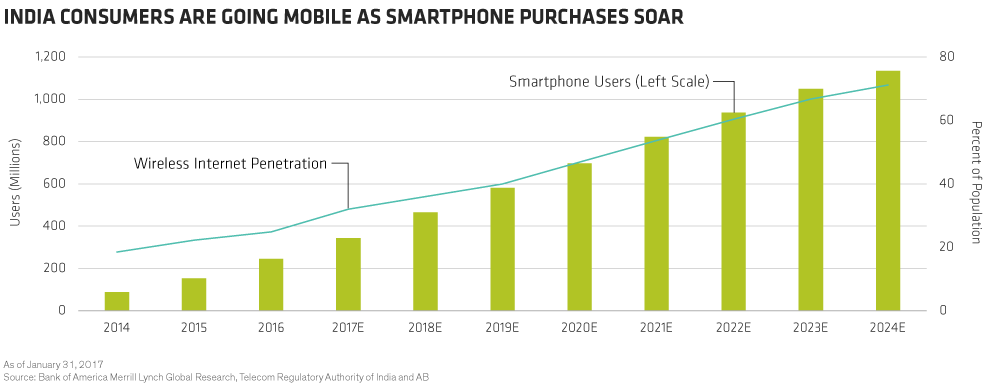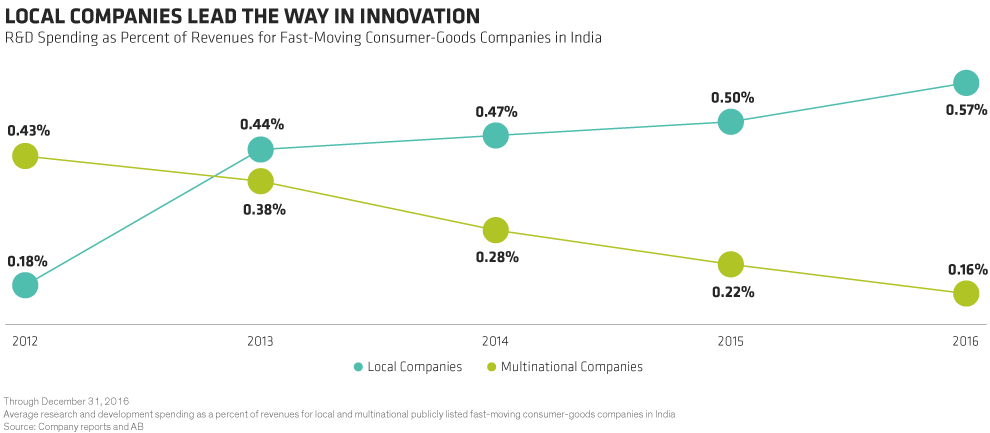Government-led initiatives are shaking up the economic landscape in India. Despite the challenges, we discovered that consumers are embracing change and feeling confident about the future in ways that could open new opportunities for investors.
India is a vast country, with 29 states, 22 official languages and 1,652 dialects spoken. Local elections taking place today could bolster support for Prime Minister Narendra Modi—or further stoke divisions across the country. Yet beyond politics, technology is helping to unify a diverse country, disrupt business models and influence consumption trends.
We recently traveled to large and small cities across India to interview people of all ages. Our research revealed that consumers are in high spirits and generally supportive of recent government initiatives to modernize their economy.
Welcoming Change
Take, for example, the accommodative response to the Modi administration’s demonetization last November, which deemed 86% of the value of banknotes in circulation invalid. Despite the action’s initial upheaval, most people we spoke to believed that it would ultimately improve the fairness of the system.
This was the case for Prithvi, a 30-year-old project supervisor in Bangalore, who was confident that demonetization will significantly decrease corruption in the country over the next several years. And, like many younger Indians, he now uses mainly credit cards and mobile wallets to make payments. Prithvi is one of the more than 300 million mostly Indian urbanites who have become avid users of mobile data services.
With a growing number of retail outlets accepting e-wallets, the younger generations don’t see the need to go back to cash. And, in a trend we call “reverse nurturing,” younger generations are slowly convincing their reluctant older friends and family members to accept newer technologies. We see demonetization creating a distinct opportunity for mobile-payment services providers to serve India’s large, unbanked population.
India’s Budding Mobile Culture
India stands as one of the most attractive consumer markets in the world. Nearly two-thirds of its population is below 35 years old, and disposable income is projected to grow 17% annually in the 2014−2020 time frame.
The Internet is opening new vistas and unlocking spending power for many consumers. India is now the second-largest Internet market in the world, after China—despite a user penetration rate of only 25%, compared with 46% in China and more than 80% in developed markets such as Japan and the US. Internet usage is forecast to more than double by 2022, spurred mainly by surging mobile subscription growth as smartphone prices fall and telecom providers aggressively promote data services (Display).

The spread of online services to smaller towns and rural areas is also giving people more options in where and how they live. They no longer need to move to a big city to get the modern lifestyles and breadth of entertainment they desire. Hemlata, a 29-year housewife, told us that access to the Internet made it possible for her and her family to move from the challenges of overcrowded Mumbai to a better lifestyle in smaller Nagpur. She and her brother are in the process of launching an online clothing business.
Tradition with a Modern Twist
Nonetheless, businesses seeking to cater to these shoppers must also understand the importance of family and nation in Indian society. While Indian consumers are highly value driven and embracing modern ways, they increasingly want products that reflect local traditions.
Creative local companies are heeding the call. With products offering tradition with a modern twist, these newcomers are taking market share from longtime multinational incumbents, many of which seem more focused on cost-cutting than on innovation (Display). For instance, fast-growing Patanjali Ayurveda offers an array of consumer-goods products that leverage the surging appeal of traditional Indian Ayurveda herbal compounds.

Another example is Hector Beverages, a private company enjoying phenomenal growth. Hector’s popular Paper Boat juices brand goes head-to-head with global giants like Coca-Cola and PepsiCo. Its juices feature Indian spices and condiments, are made without preservatives, added color or carbonation, and come in flavors such as Aam Panna (raw mango), Chili Guava and Neer More (curd based).
Empowering Opportunity
Amid all of these changes, we find a positive view of the future. Though execution is key, government-led reforms are promising to support India’s growth path. Technology is empowering consumers and affecting everyday life. The opportunity is big, and investors can benefit over the long term by identifying emerging local companies and incumbents that are able to drive innovation, disrupt business models and adapt to emerging opportunities.
The views expressed herein do not constitute research, investment advice or trade recommendations and do not necessarily represent the views of all AB portfolio-management teams.